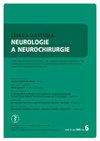COVID-19大流行情况下胶质母细胞瘤辅助治疗的“新常态
IF 0.4
4区 医学
Q4 NEUROSCIENCES
引用次数: 0
摘要
在受新冠肺炎大流行影响的国家,大多数中心的神经外科干预数量减少了50%以上,由于预后差和与快速进展相关的生物学特性,确定治疗重点变得至关重要。IV级恶性胶质瘤优先治疗重症监护病房住院可能性的严重限制和给予辅助治疗的可能性的减少,导致在决定新发多形胶质母细胞瘤的神经外科治疗时,必须考虑及时给予辅助治疗的可能性,以便作出合理的多学科团队评估应尽可能评估异柠檬酸脱氢酶(IDH)突变和o6 -甲基鸟嘌呤- dna甲基转移酶(MGMT)甲基化状态IDH野生型状态应是优先治疗的决定性因素。对于表现状态良好的年轻患者,标准治疗包括长疗程放疗加替莫唑胺并发替莫唑胺6周期辅助治疗。即使在COVID-19大流行的情况下,老年人和/或体弱患者的最佳治疗选择包括在3周内15次每日40 Gy的中度低分割放疗方案,或在考虑年龄和Karnoffsky性能状态的情况下,5次每日25 Gy的低分割放疗方案。在决定是否省略化疗和实施短疗程放疗方案(25 Gy分5段)时,必须考虑MGMT甲基化状态。省略化疗应同时考虑SARS-CoV-2感染的额外风险和MGMT未甲基化情况下使用temozolomide治疗的有限益处©2021,捷克医学协会J E Purkyne版权所有本文章由计算机程序翻译,如有差异,请以英文原文为准。
The “new normal” for glioblastoma adjuvant treatment in a COVID-19 pandemic scenario
Multidisciplinary treatment of brain tumors has been severely affected by the COVID-19 pandemic In the context of a decrease in the number of neurosurgical interventions by over 50% in most centers from the countries affected by the pandemic, the setting of treatment priorities becomes essential Due to the poor prognosis and biological particularities related to rapid progression, grade IV malignant gliomas are a priority in treatment The severe limitations of hospitalization possibilities in intensive care units and the reduction of the possibilities of administration of adjuvant treatment leads to the necessity to take into account the possibilities for timely administration of adjuvant treatment in the decision for the neurosurgical treatment in new glioblastoma multiforme cases Multidisciplinary team evaluation of each case is mandatory in order to make a rational decision Isocitrate dehydrogenase (IDH) mutation and methylation status of O6-methylguanine-DNA methyl-transferase (MGMT) should be assessed as far as possible IDH wild-type status should be a decisive factor in prioritizing the treatment For young patients with a favorable performance status, the standard treatment includes long-course radiotherapy with concurrent temozolomide treatment, followed by 6-cycle adjuvant treatment with temozolomide, even in a COVID-19 pandemic scenario The optimal therapeutic choice in the case of elderly and/or frail patients includes a moderate hypofractionated radiotherapy regimen of 40 Gy in 15 daily fractions over 3 weeks, or a hypofractionated protocol with 25 Gy in 5 daily fractions, taking into account the age and Karnoffsky performance status Also, the MGMT methylation status must be taken into account for the decision to omit chemotherapy and for the delivery of a short-course radiotherapy regimen (25 Gy in 5 fractions) Omission of chemotherapy should consider both the additional risk of SARS-CoV-2 infection and the limited benefit of temozolomide treatment in the case of unmethylated MGMT status © 2021, Czech Medical Association J E Purkyne All rights reserved
求助全文
通过发布文献求助,成功后即可免费获取论文全文。
去求助
来源期刊
CiteScore
0.70
自引率
60.00%
发文量
37
审稿时长
4-8 weeks
期刊介绍:
The Czech and Slovak Neurology and Neurosurgery is the official journal of five Czech and Slovak expert societies: the Czech Neurological Society, Slovak Neurological Society, Czech Neurosurgical Society, Slovak Neurosurgical Society and the Czech Society of Paediatric Neurology.
The journal is intended for all physicians interested in neuroscience, practical or theoretical.
The journal publishes original practice-based as well as basic research-focused neurological and neurosurgical papers, brief communications and case studies, all vigorously peer-reviewed, as well as review papers, commentaries, diagnostic and treatment standards and various thematic series (minimonographs with a knowledge test, statistical or web insights).

 求助内容:
求助内容: 应助结果提醒方式:
应助结果提醒方式:


